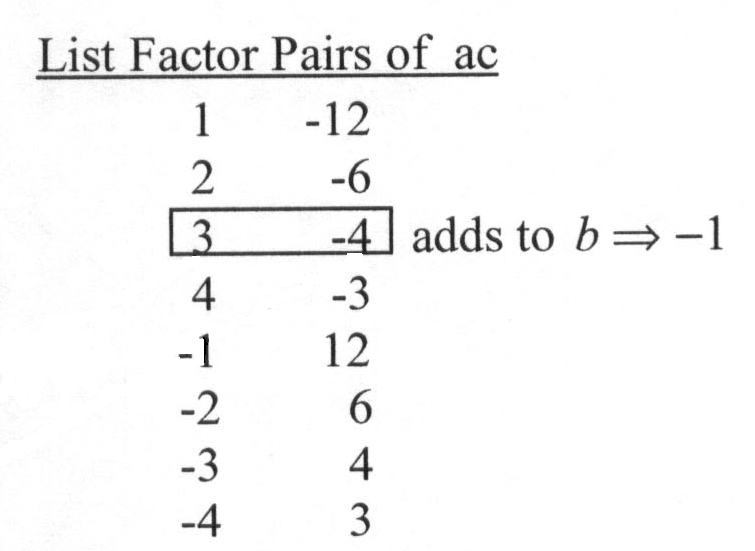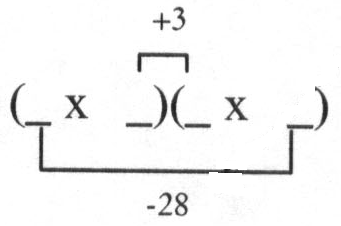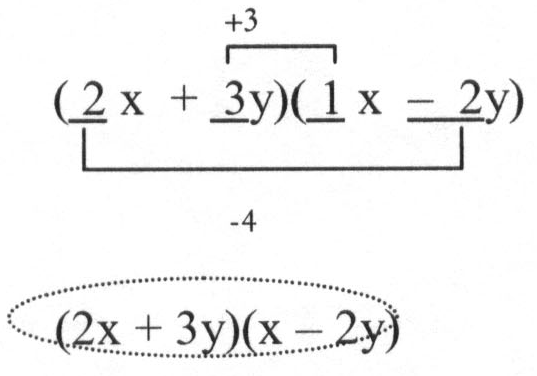Factoring Polynomials

When factoring is completed:
1) Check to see if one of the polynomial factors can be factored again.
2) Double check for other GCFs (greatest common factors)
I.GCF Greatest Common Factor
> A factor that every term in the expression has in
common
> Reverse distribution
Examplea: To find the GCF for 12x4 - 6x3+ 3x2
12x4-6x3+3x2 means (2·2·3·x·x·x·x)-(2·3·x·x·x)+(3·x·x)
all three terms have 3 and x·x as common factors
![]()
So the GCG is 3x2
Note:
1) 3 is the greatest common numerical factor because it is the largest number
that divides into every term evenly.
2) x2 is the greatest common variable factor because it is the variable to the
largest power that divides evenly into all three terms.
To factor 12x4-6x3+3x2 thi9ne reverse distribution 3x2(4x2-2x+1)
II. Factoring Trinomials (ax2+bx+c)
i) Special Case (Perfect Square Trinomial)
Strategy: Test the trinomial to see if it satisfies the conditions of a
Perfect Square Trinomial.
A Perfect Square Trinomial:
A2+2AB+B2 factors into (A+B)(A+B) which can be written (A+B)2
or
A2-2AB+B2 factors into (A-B)(A-B) which can be written (A-B)2
TEST:i) 1st and last terms must be perfect squares.
ii)│middle term │must equal 2 times the roots of the 1st and last
terms.
Example: Factor 9x2-24x+6
Test:
i) 1st term is 9x2 (3x2) and last term is 16 (4)2, both perfect
squares with roots 3x and 4 as shown.
ii) does the│ middle term│ 24x equal 2(3x)(4)? YES!
The trinomial passes both test. It is a Perfect Square
Triniomial of the type
A2-2AB+B2=(A-B)2 where 3x →A
and 4 →B
Solution:(3x-4)2
ii) For a = 1 (lead coefficient is 1)
Strategy: Find the product ac then determine which factor pairs of ac add up to b.
Ecample: Factor x2-x-12 Note: a=1,b=-1,and c=-12
ac==>(1)(-12)=-12=ac

Note:
i) You don’t have to list all
factor pairs, just find the two that add to b.
ii) If there are no factor pairs that add to b then the polynomial is "prime".
Solution must be of the form (x _)(x _) where the factor pair and corresponding positive or negative sign supply the missing terms.
Solution:(x+3)(x-4)
iii) For a≠1
Strategy: Find the product ac then determine the factor pairs of ac that add up to b.
Examole: Factor 4x2-25x-21 Note: a=4.b=-25,c=-21
![]()

Note: i) You don't have to list all factor pairs, just find the two shat add to b.
ii) If there are no factor pairs that add to b then the polynomial is " prime".
Solution must be of the form (_x _)(_x _)
Clues to help you find the missing coefficients and terms:
i) List the factor pairs of a to find possible
coefficients of x.
ii) List the factor pairs of c to possible missing final terms.
iii) Product of "inners"
and "outers" must be from the list of factor pairs of ac above that
to b.
Product of "inners"
and "outers" must be from the list of factor pairs of ac above that
to b.
Solution:(4x+3)(x-7)
III. Factor by Grouping(4 Terms)
Strategy: Group the four terms in pairs and find the GCF of each pair. Both pairs should then have
a common binomial factor.
Example 1:Factor 3ax-3ay-2bx+2by
3ax-3ay-2bx+2by
GCF of 1st group is 3a
GCF of 2nd group is -2b
(Note: If the two groups are separated by a subtraction always factor out a negative GCF from the
second group.)
Factoring each group yields 3a(x-y)-2b(x-y)
Both have a common binomial factor (x-y) which can be factored out leaving the other factor(3a-2b).
Solution: (x-y)(3a-2b)
Example 2: Factor 4X2-25X-21
Strategy: Notice!...this polynomial is the same as in section II and it doesn't have 4 terms. But,
if we replace the middle term-25x with the factor pair of ac from the list that adds to -25 we can
write this trinomial with 4 terms and solve by grouping .This is an alternative way of factoring a
trinomial where a≠1.
4x2-28x+3x-21
GCF of 1st group is 4x
GCF of 2nd group if 3
Factoring each group yields 4x(x-7)+3(x-7)
Both have a common binomial factou (x-7) which can be factored out leaving the other factor(4x-3)
Solution: (x-7)(4x-3)
Ⅳ. Special Cases (2 Terms)
i) Difference of Squares
Strategy: Check the binomial to see if it is a difference of squares.
A Difference of Squares A2-B2 factors into (A+B)(A-B)
TEST:
i) 1st and last terms must be perfect squares.
ii) Must be a subtraction.
NOTE: Besides a possible common factor, the Sum of Squares A2 + B2 is PRIME (not factorable).
Example: Factor 9x2-16
Test:
i) 1st term is 9x2 →(3x)2 and last term, is 16→ (4)2,both perfect
squares with roots 3x and 4 as shown.
ii) are we subtracting? YES!
The binomial passes both test. It is a Difference of
Squares of the form
A2-B2 = (A+B)(A-B) where 3x →A
and 4→ B
Solution: (3x+4)(3x-4)
ii) Difference OR Sum of Cubes
Strategy: Check the binomial to see if it is a difference of cubes or a sum of cubes.
A Difference of Cubes A3-B3 factors into
(A-B)(A2+AB+B2)
A Sum of Cubes A3+B3 factor into (A+B)(A2-AB+B2)
Note: The trinomial factor is often PRLME and cannot be factored further.
TEST:
i) 1st and last terms must be perfect cubes.
ii) Can be erther a subtraction OR an addition.
Example 1: Factor 27x3+8
Test:
i) 1st term is 27x3 →(3x)3 and last term is 8→ (2)3,both perfect
cubes with roots 3x and 2 as shown.
ii) it is the sum of cubes.
The binomial is a Sum of Cubes of the form
A3+B3 = (A+B)(A2-AB+B2)
where 3x→ A and 2
→B
Solution: (3x+2)(9z2-6x+4)
Example 2: Factor 1-64x3
Test:
i) 1st term is 1 →(1)3 and last term is 64x3 →(4x)3, both perfect
cubes with roots 1 and 4x as shown.
ii) it is the difference of cubes.
The binomial is a Difference of Cubes of the form
A3-B3 = (A-B)(A2+AB+B2)
where 1 →A and 4x→
B
Solution: (1-4x)(1+4x+16x2)
WORKED EXAMPLES
1. Factor 16x4-1
(4x2)2-(1)2 Difference of Squares
(4x2+1)(4x2-1) Another Difference of Squares!
(4x2+1)((2x)2-(1)2)
(4x2+1)(2x+1)(2x-1)
2. Factor 3x2+27
3(x2+9)
GCF
(X2+9) can NOT be factored further it is the Sum of Squares which is
prime.
3. Factor 8a3+27b3
(2a)3+(3b)3 Sum of Cubes
(2a+3b)(4a2-6ab+9b2)
4. Factor 2x2-xy-6y2
(_x_y)(_x_y) Factor pairs of ac = -12 that add to the
middle are 3 and -4

Practice Exercises
![]()
![]()
![]()
![]()
![]()
![]()
![]()
![]()
![]()
![]()
Answers to Practice Ecercises





